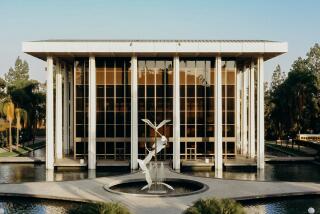SILENT SCREENS : Encore for Carter, Old Movie District
For six months in 1926, Gaylord Carter watched MGMâs âBen Hurâ almost every night as he played the silent filmâs musical score on the Million Dollar Theaterâs house organ.
Wednesday night at the Orpheum (another relic from the Downtown movie district), the 88-year-old organist will again get the chance to see what he describes as one of his favorite films--and he wonât even have to work the show.
Carter, along with ticket holders for the Los Angeles Conservancyâs Last Remaining Seats series, will watch a restored print of the film and hear the praise of fellow film buffs, who are planning a tribute to Carter, once Southern Californiaâs pre-eminent silent-film organist. The series, in which classic films are shown in downtown L.A. movie palaces, takes place each Wednesday in June.
âWhat do you do when people say they want to say some nice things about you?â the semi-retired Carter asks rhetorically. âThey said a friend of mine would sit and play the organ and Iâd get to take bows and be introduced by Leonard Maltin.â
In a way, the ornate Orpheum Theater, at 842 S. Broadway, also will be taking a bow Wednesday as it again presents the kind of grand-scale entertainment it was built for in 1926 (it still shows first-run films, usually with Spanish subtitles). âBen Hur,â directed by Fred Niblo, was filmed at a budget of $4 million, a record for its day; its chariot race and sea battle are thought to be as impressive as those of the 1959 version that starred Charlton Heston. The film is in black-and-white, with some sequences in two-color Technicolor.
Carter was familiar with many of the classic theaters during their glory days. He remembers moving to Los Angeles with his family in 1922 and being very impressed with the Million Dollar Theater on Broadway. A few years later, he became the theaterâs head organist, and he played the musical scores for many films, including âBen Hur.â âIt was the first time a movie ever lasted six months in Los Angeles,â he says. âI was bowled over by it. . . . Itâs a phenomenal score--the music for the galley slave scene is tremendous.â
By the late 1920s, âtalkiesâ had started to replace silent films, and by 1935, after working at several other theaters, Carter went into radio. He still remembers the old theaters fondly, though, and when the conservancy started Last Remaining Seats in 1987, it hired him to accompany some of the silent films it presented, an experience he says he enjoyed. Carter rarely plays now, though, and on Wednesday the âBen Hurâ score will be performed by his friend and colleague Stan Kann.
Gregg Davidson, the conservancyâs associate director, hopes that shows such as this tribute and the vaudeville celebration will help make a public accustomed to seeing films on mall multiplex screens aware of the historical importance of the downtown theaters.
âWhen we started this, the naysayers said no one will go downtown to an old theater to see an old movie in the middle of the summer,â Davidson says, adding that each show attracts about 1,500 people. âBut we get a number of people who have never seen a movie in a theater with a balcony. The older people (go) for nostalgia. And the movie people--seeing a classic film on a big screen is a different experience.â
In a way, Carterâs career has paralleled that of the Broadway theaters. âWe feel that as the conservancy works to preserve architectural landmarks, we are honoring Gaylord Carter as a living landmark,â says Bill Gorin, the chairman of the conservancyâs theater committee.
For more information on the series, call (213) 623-CITY.
More to Read
Only good movies
Get the Indie Focus newsletter, Mark Olsen's weekly guide to the world of cinema.
You may occasionally receive promotional content from the Los Angeles Times.










